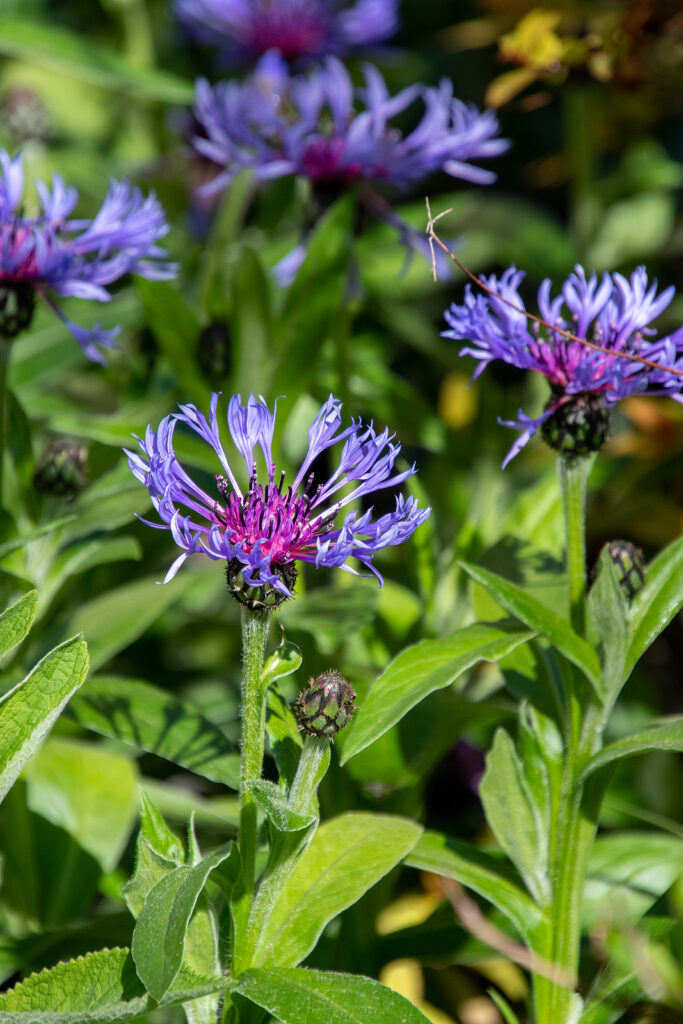How to Grow Perennial Cornflower — Centaurea montana
Centaurea montana–known as perennial cornflower–bears thistle-like flowers in shades of purple, blue, white, or pink. Perennial cornflower is also called mountain knapweed, and mountain bluet. It is part of the Centaurea genus which also includes the annual cornflower called bachelor’s button, Centaurea cyanus, as well as Dusty Miller, Centaurea gymnocarpa.
Centaurea montana–perennial cornflower–is also called mountain bluet and mountain knapweed. It has wide, feathery, pale blue flowers about twice as wide as the bachelor’s button, the annual cornflower. Flowers bloom from spring to summer. They are cottage garden favorites; let them spread beside a wall or hedge. They are also a good choice for rock gardens and arid gardens.
Related Centaurea articles:
How to Grow and Care for Dusty Miller – Centaurea cineraria
How to Grow and Care for Bachelor’s Button — Centaurea cyanus

Get to know Centaurea — perennial cornflower
- Plant type: Perennial
- Growing Zones and range: Zones 4-8
- Height and width: 18 to 24 inches (45-61cm) tall and wide
- Foliage: Spreading plant with oval, tapering narrow leaves that are hairy beneath
- Flowers: Starburst-shaped deep blue flowers 2-inches (5cm) across
- Bloom time: Spring through mid-summer
- Uses: Meadow gardens, cottage gardens, rock gardens, mass in large beds
- Common name: Perennial cornflower, mountain bluet, mountain knapweed
- Botanical name: Centaurea montana
- Family: Asteraceae
- Origin: Europe and the Mediterranean
Where to plant Centaurea — perennial cornflower
- Plant Centaurea-perennial cornflowers in full sun.
- Grow Centaurea-perennial cornflower in average to sandy soil with excellent drainage.

When to plant Centaurea — perennial cornflower
- Start seed indoors 8 to 10 weeks before the last frost in spring. In Zones 9-11, start seed in autumn.
- Set Centaurea-perennial cornflower seedlings in the garden in the early spring of fall.
Planting and spacing Centaurea — perennial cornflower
- Indoors sow seed in flats or individual pots; sow seeds 1/8 inch deep; keep the temperature at 65° to 75°F (18°-24°C); seeds will germinate in about 7 days.
- Sow seed outdoors about 2 inches (5cm) apart and cover with 1/4 inch of soil. Keep the soil just moist.
- Set plants outdoors in their permanent place after hardening off seedlings for several days; transplant Centaurea-perennial cornflower to the garden after all danger of frost has passed.
- Space Centaurea-perennial cornflowers 18 to 24 inches apart.
How to water and feed Centaurea — perennial cornflower
- Keep the soil evenly moist.
- Fertilize cornflowers lightly with a slow-release fertilizer.
- Mulch around plants with chopped leaves or aged compost.
- Pinch off the top inch of growth to promote bushiness when plants are about 8 inches (20cm) tall.
- Pests and diseases are rarely a problem.
Centaurea — perennial cornflower care
- Mulch around Centaurea-perennial cornflowers with aged compost.
- Trim off spent blooms to prevent excessive reseeding and to promote new blooms.
- Stake tall plants to prevent them from flopping over.
- Divide Centaurea-perennial cornflowers every 3 to 4 years.
- Centaurea cornflowers are susceptible to slugs and snails.
Centaurea — perennial cornflower propagation
- Divide and reset crowded perennials in spring when new growth begins.

Other members of the centaurea genus
- Centaurea cyanus, bachelor’s button, cornflower, is a hardy annual with bright blue tufted round blossoms.
- C. dealbata, Persian cornflowers, is a perennial that grows to 2 feet tall and 3 feet wide.
- C. gymnocarpa, dusty miller, is a tender perennial grown for its divided, feltlike, gray-white leaves.
- C. moschata, Sweet sultan, is a half-hardy annual that needs warm weather; its flowers are large and silky.







